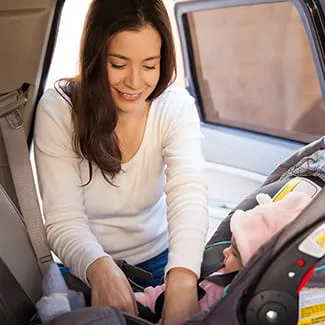September 21, 2020

Whether you're a new parent or expecting a baby in the near future – congratulations! Welcoming a new baby is one of the most exciting, challenging and rewarding times of your life. We know you have a lot on your mind, including how to prepare for and protect your new little one. It can be overwhelming, so helping you break down one of the best ways you can keep your child safe – properly installing and using a car seat.
So how do you know you're choosing and using the right car seat? Below are a few helpful tips from the experts at Car Seats Colorado.
Picking a Car Seat: More Expensive Does Not Mean Safer
A car seat is one of the most important items you will ever buy for your child. But it does not need to be the most expensive. All new car seats — the $40 ones and those that run $400 — must pass the same stringent crash safety standards. So no need to break the bank – find a car seat that works for your family and your budget. And if you are accepting a used car seat from someone, make sure you know its entire history. Even if it's not visible, car seats that have been in a crash or have been dropped can have structural damage that makes them unsafe. Also know that car seats have an expiration date, which should be clearly listed on the seat itself.
Installing a Car Seat: Read the Manual
Three out of four children are not properly secured in their car seat – many times because of improper installation. Every vehicle is different, and every car seat is different. Once you've selected a car seat, read the manual to understand how to properly install the seat in your vehicle. You will also want to reference your vehicle owner's manual because installation is not universal and can vary from car to car.
After you've installed your car seat, have it inspected by a certified car seat technician. Find a free inspection location near you. It's important to do this before you plan to bring your baby home from the hospital.
Using a Car Seat: Ensure a Snug Fit
The "pinch test" is a great way to ensure your child is snug and safe in their car seat.
First, buckle the harness, secure the chest clip (at armpit or nipple level) and tighten the straps. Pinch the harness webbing at the child's shoulder vertically between your thumb and forefinger. If you are able to pinch webbing between your fingers, the harness is not tight enough. Your fingers should easily slide off the webbing when pinched.

Know When to Move Your Child to the Next Seat
There are three types of car seats that your child will progress through as they grow – rear-facing, forward-facing, and booster seats. Don't rush to the next seat before your child is ready. Children should be in a car seat that fits their size and development, not just their age.
Rear-Facing Seat
You'll want to use this from the time you bring your child home from the hospital until they exceed the maximum height and/or weight limit for the rear-facing position listed by the car seat's manufacturer. It's important to keep your child rear-facing for as long as possible as this is the safest position for them in the event of a crash. Click here for a guide to rear-facing car seats.
Front-Facing Seat
Once your child outgrows the rear-facing position, you can move them to a forward-facing seat. Most children will be in a forward-facing seat until about age five or until they outgrow the car seat's maximum height or weight limit (noticing a pattern here?). Every child is different, so this may be sooner or later than age five. Click here for a guide to forward-facing seats.
Booster Seat
Once they've outgrown the height and weight limits on a forward-facing seat, they can transition to a booster seat. Kids should be in a booster seat until a seat belt fits them properly. This is usually when they're about 57 inches tall. For many kids, that’s around age eight, but this can vary based on their development and maturity level. Click here for a guide to booster seats.
Transitioning to a Seat Belt
More than 25 percent of all kids are moved to seat belts too soon, when they should still be riding in booster seats. Kids can start wearing a regular seat belt when they can rest their back against the seat of the car and bend their knees over the edge of the seat. The lap belt should fit comfortably across the thighs and the shoulder strap should go across the chest. If the seat belt does not fit them properly, it won't protect your child and could cause serious injury. Click here to see if your child is in the right seat.
Check for Recalls
Car seat safety recalls happen more often than you think. Last year alone, recalls affected 755,000 individual car seats. Register your car seat with the manufacturer to receive recalls and safety notices so your child can remain safe.
Denver Health has partnered with Car Seats Colorado, which is comprised of the Colorado State Patrol, CDOT, local car seat technicians, law enforcement, emergency services and other professionals who are dedicated to implementing child passenger safety programs and encouraging parents to take the necessary steps to protect their children when in vehicles. Learn more about how to keep children safe in vehicles at CarSeatsColorado.com.

